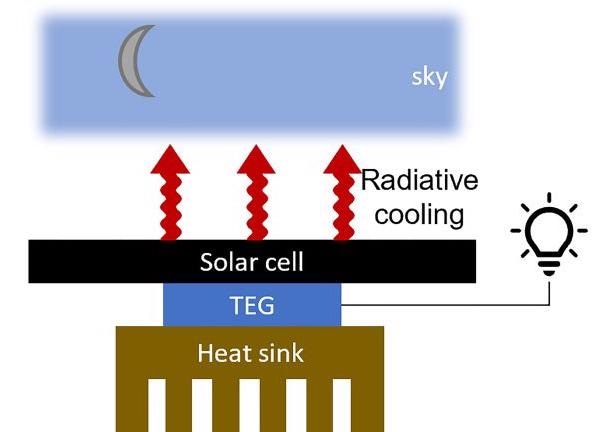Reviewed by Alex SmithApr 6 2022
Around 750 million people do not have access to electricity at night. Solar cells deliver energy during the daytime, but storing it for later use necessitates substantial battery storage.
 The device generates electricity at night from the temperature difference between the solar cell and its surroundings. Image Credit: Sid Assawaworrarit.
The device generates electricity at night from the temperature difference between the solar cell and its surroundings. Image Credit: Sid Assawaworrarit.
Researchers from Stanford University created a photovoltaic cell that extracts energy from the environment during the day and night, eliminating the need for batteries. The study was published in the journal Applied Physics Letters, published by AIP Publishing. The device utilizes heat that escapes from Earth and is emitted into space — energy that is on par with incoming solar radiation.
Solar cells emit and lose heat to the sky at night, attaining temperatures a few degrees below ambient air temperature. A thermoelectric module is used in the device under development to produce voltage and current from the temperature gradient between the cell and the air. This process is dependent on the system’s thermal design, which encompasses a hot and cold side.
You want the thermoelectric to have very good contact with both the cold side, which is the solar cell, and the hot side, which is the ambient environment. If you don’t have that, you’re not going to get much power out of it.
Sid Assawaworrarit, Study Author, Stanford University
The researchers demonstrated power generation in the device during the daytime, at night and when it runs in reverse and adds additional power to a conventional solar cell.
The system is cost-effective and could theoretically be integrated into existing solar cells. It is also simple enough that it can be built in remote areas with limited resources.
What we managed to do here is build the whole thing from off-the-shelf components, have a very good thermal contact, and the most expensive thing in the whole setup was the thermoelectric itself.
Sid Assawaworrarit, Study Author, Stanford University
Utilizing electricity at night for lighting necessitates only a few watts of power. As the device produces 50 mW/m2, lighting would require approximately 20 m2 of photovoltaic area.
None of these components were specifically engineered for this purpose. So, I think there’s room for improvement, in the sense that, if one really engineered each of these components for our purpose, I think the performance could be better.
Shanhui Fan, Study Author, Stanford University
The researchers intend to improve the device’s thermal insulation and thermoelectric components. They are looking into ways to improve the solar cell’s radiative cooling performance without compromising its solar energy harvesting potential.
Journal Reference:
Assawaworrarit, S., et al. (2022) Nighttime electric power generation at a density of 50 mW/m2 via radiative cooling of a photovoltaic cell. Applied Physics Letters. doi.org/10.1063/5.0085205.